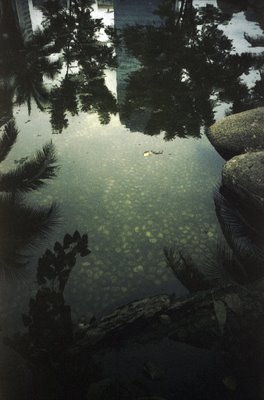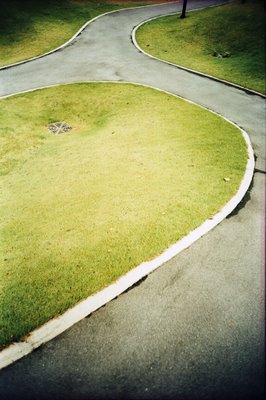Lomo Compact Automat, Niet Automat

When two Austrians picked up a piece of Soviet-era junk and decided they would bring it to the information-age masses of the capitalist world, they started a revolution that has become a legend. It took Vladimir Putin (ex-chief of KGB and Russia's current top dog) himself to ok the Austrian duo's plan to export his hometown's secret weapon, the Lomo Compact Automat, and the rest is history. The little black camera has since sold around the world and reached cult-status with such VIP users as Yasser Arafat (ex-user actually) and His Holiness the Dalai Lamai.

Lomo is now almost a synonym for the analog movement in its entirety and the dirty little secret is that most of it has nothing to do with the camera. Lomo users cross-process their film, which is what gives the wild colors and killer contrast. To cross-process is to use slide film and ask your lab to develop it as regular negative color film--basically use the wrong chemicals (see the Holga post). The final touch comes from the Lomo being a pretty bad camera. The dark corners it produces are from poor lens design. As for the under and over-exposures, they're from sub-par metering (the camera's ability to judge how to best capture the scene you're photographing). Normally these are considered inexcusable flaws which lens and camera makers spend millions of dollars in R&D to reduce to a minimum. But the genius behind the Lomo is to make their deffects selling points by turning them into the shortest path to developing a style of photography that doesn't look like everybody else's. The LCA can be found at http://shop.lomography.com for USD 200 (B16,000). Another option is the Olympus XA series cameras, reputed similar to the Lomo. Those start at 20 USD (B800) on www.ebay.com and occasionaly pop up at the antique camera dealers at Pirom Plaza (Mahachai Rd., across Merry King and next to Grande Ville Hotel, map).

Tested at Benjakitti Park (Th. Radchadaphisek, MRT Queen Sirikit Convention Center, BTS Asok) with Fuji Provia 100F 35mm film.
TIP: For cross-processing, make sure you buy Fuji Provia film and go to a smart lab that understands, "Can you please cross-process this?" We went straight to the pros with our batch--IQ Lab

Now here's the unspeakable truth.
Half the pictures on the roll are completely dark. 4 shots are properly exposed (I mean within like a couple stops of latitude) and the rest really needed a lot of help during scanning (way too dark or bright). No shots were completely burnt out. I know that cross-processing + slide film (naturally contrasty) doesn't leave a lot of latitude when shooting but this is just ridiculous. If the cell on the Lomo Kompact Automat is that useless, it might as well not be there. The Holga, with its rudimentary sun/shade settings proves proves much more useable with a near 100% useability rate on the two rolls I shot with it. I'll have to ask Analog Memory what I'm doing wrong or if I should just take a beneath 50% success rate as part of the Lomo Experience.
Still, and like the Holga, I really like some of these shots. The thing with 35mm film is that it's easy to find places that sell it, process it, and put it on CD. 35mm is also cheaper than medium format per picture but if you consider the price in relation to surface of celluloid, medium format is not more expensive. I'm very interested in the Olympus XA which actually has rangefinder focus! Some people consider it a worthy alternative to the Lomo LCA. Ken Rockwell reviewed it here and thinks it's an excellent camera. Not too excellent, I hope.
MeteringSo I went on PBase to see real-life shots (here) taken with XA but I don't see any vignetting, unfortunately. I really liked what people were doing with it though. It kind of upholds my theory that some cameras have a little magic in them.
Great! I always shot Fuji Velvia 50 slide film in them.
I preferred the XA2. It's meter was more consistent and had a clearer center weighted pattern. I preferred the full program automation. The XA's meter had a weird sensitivity pattern which extended beyond the image.
The meters are traditional and non-evaluative. You must use use the Zone System and compensate for light and dark subjects. I set the ISO lower to increase exposure and higher to reduce it.
The XA adds a +1.5 stop backlight position.
Lens
Both lenses are sharp. The XA has a very complex lens design allowing it to fit in the camera without needing to retract or extend, and as a result of this design has some barrel distortion and light falloff at all apertures.









1 Comments:
There is definitely something about the feel of these images, almost a texture.
Perhaps one should create a Photoshop action to apply a uniform degradation of some kind to one's perfectly metered and rendered shots, to create one's look.
Ideally, these degradations would not be a copy of what a Lomo or Holga does, but something new...
Post a Comment
<< Home